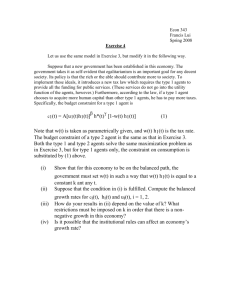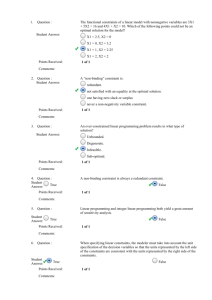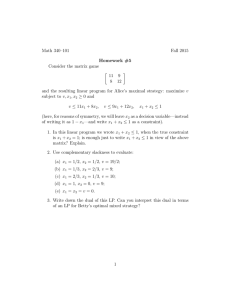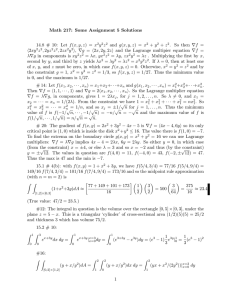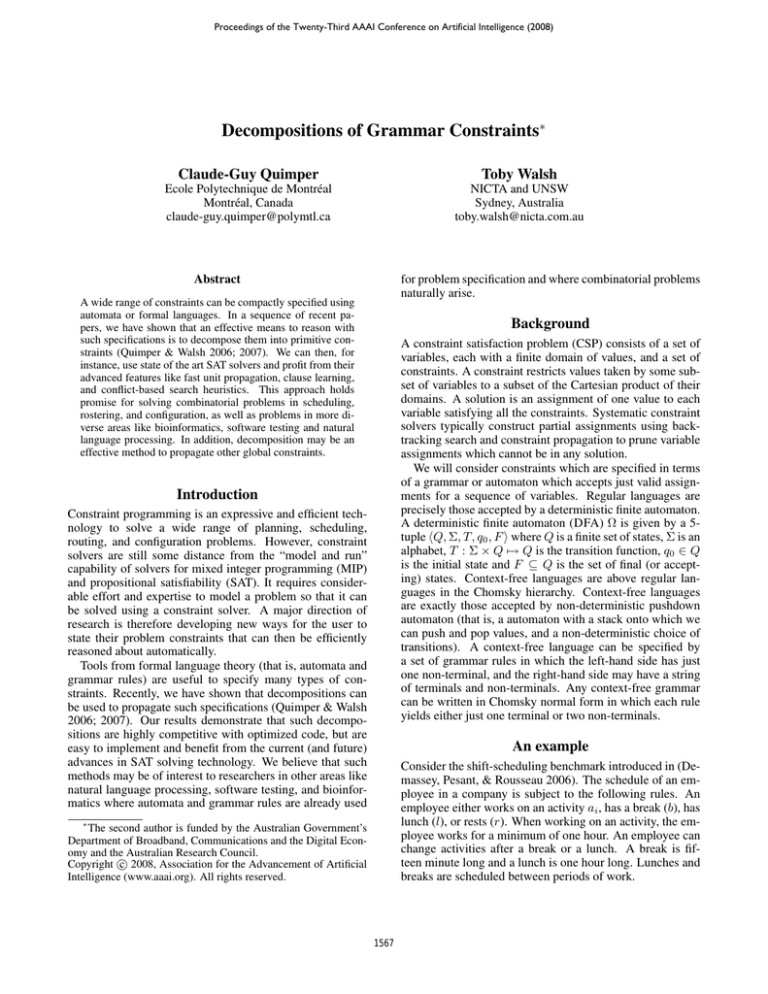
Proceedings of the Twenty-Third AAAI Conference on Artificial Intelligence (2008)
Decompositions of Grammar Constraints∗
Claude-Guy Quimper
Toby Walsh
Ecole Polytechnique de Montréal
Montréal, Canada
claude-guy.quimper@polymtl.ca
NICTA and UNSW
Sydney, Australia
toby.walsh@nicta.com.au
Abstract
for problem specification and where combinatorial problems
naturally arise.
A wide range of constraints can be compactly specified using
automata or formal languages. In a sequence of recent papers, we have shown that an effective means to reason with
such specifications is to decompose them into primitive constraints (Quimper & Walsh 2006; 2007). We can then, for
instance, use state of the art SAT solvers and profit from their
advanced features like fast unit propagation, clause learning,
and conflict-based search heuristics. This approach holds
promise for solving combinatorial problems in scheduling,
rostering, and configuration, as well as problems in more diverse areas like bioinformatics, software testing and natural
language processing. In addition, decomposition may be an
effective method to propagate other global constraints.
Background
A constraint satisfaction problem (CSP) consists of a set of
variables, each with a finite domain of values, and a set of
constraints. A constraint restricts values taken by some subset of variables to a subset of the Cartesian product of their
domains. A solution is an assignment of one value to each
variable satisfying all the constraints. Systematic constraint
solvers typically construct partial assignments using backtracking search and constraint propagation to prune variable
assignments which cannot be in any solution.
We will consider constraints which are specified in terms
of a grammar or automaton which accepts just valid assignments for a sequence of variables. Regular languages are
precisely those accepted by a deterministic finite automaton.
A deterministic finite automaton (DFA) Ω is given by a 5tuple hQ, Σ, T, q0 , F i where Q is a finite set of states, Σ is an
alphabet, T : Σ × Q 7→ Q is the transition function, q0 ∈ Q
is the initial state and F ⊆ Q is the set of final (or accepting) states. Context-free languages are above regular languages in the Chomsky hierarchy. Context-free languages
are exactly those accepted by non-deterministic pushdown
automaton (that is, a automaton with a stack onto which we
can push and pop values, and a non-deterministic choice of
transitions). A context-free language can be specified by
a set of grammar rules in which the left-hand side has just
one non-terminal, and the right-hand side may have a string
of terminals and non-terminals. Any context-free grammar
can be written in Chomsky normal form in which each rule
yields either just one terminal or two non-terminals.
Introduction
Constraint programming is an expressive and efficient technology to solve a wide range of planning, scheduling,
routing, and configuration problems. However, constraint
solvers are still some distance from the “model and run”
capability of solvers for mixed integer programming (MIP)
and propositional satisfiability (SAT). It requires considerable effort and expertise to model a problem so that it can
be solved using a constraint solver. A major direction of
research is therefore developing new ways for the user to
state their problem constraints that can then be efficiently
reasoned about automatically.
Tools from formal language theory (that is, automata and
grammar rules) are useful to specify many types of constraints. Recently, we have shown that decompositions can
be used to propagate such specifications (Quimper & Walsh
2006; 2007). Our results demonstrate that such decompositions are highly competitive with optimized code, but are
easy to implement and benefit from the current (and future)
advances in SAT solving technology. We believe that such
methods may be of interest to researchers in other areas like
natural language processing, software testing, and bioinformatics where automata and grammar rules are already used
An example
Consider the shift-scheduling benchmark introduced in (Demassey, Pesant, & Rousseau 2006). The schedule of an employee in a company is subject to the following rules. An
employee either works on an activity ai , has a break (b), has
lunch (l), or rests (r). When working on an activity, the employee works for a minimum of one hour. An employee can
change activities after a break or a lunch. A break is fifteen minute long and a lunch is one hour long. Lunches and
breaks are scheduled between periods of work.
∗
The second author is funded by the Australian Government’s
Department of Broadband, Communications and the Digital Economy and the Australian Research Council.
c 2008, Association for the Advancement of Artificial
Copyright Intelligence (www.aaai.org). All rights reserved.
1567
the constraint that an employee starts off with a period of
rest (r), but once working (w) remains so until they again
rest. We can specify this with the automaton which starts
in state qr , stays in this state with r but moves to state qw
with w. From qw , the automaton stays in this state with w
but moves to state qr′ with r. Once in state qr′ , only r is
accepted. This defines the regular language r∗ w∗ r∗ which
models this constraint on work and rests.
The R EGULAR constraint can be used to encode a wide
variety of useful global constraints like the ST RETCH constraint (Pesant 2004) (which can specify constraints on the
length an employee works a continuous stretch of shifts),
and the P RECEDENCE constraint (which breaks value symmetry) (Law & Lee 2004; Walsh 2006). The R EGULAR constraint can be decomposed into a simple sequence of ternary
constraints (Quimper & Walsh 2006). We merely need to
introduce finite domain variables, Qi which stand for the
state of the automaton after i symbols, and post ternary constraints between variables representing neighbouring states
to ensure appropriate transitions occur. This decomposition
is a highly efficient and effective means to propagate the
R EGULAR constraint. The decomposition does not hinder
pruning which takes O(nd|Q|) time where n is the length of
the sequence, d is the domain size and |Q| is the number of
states of the automaton. This is asymptotically identical to
the time complexity of the more complex monolithic propagator proposed by Pesant based on dynamic programming
(Pesant 2004). More recently, Bacchus has proposed a SAT
decomposition of the R EGULAR constraint (Bacchus 2007).
This can be seen as the SAT encoding of the ternary transition constraints in our decomposition.
Another advantage of our decomposition is that we have
explicit access to the states of the automaton. Consider, for
example, a rostering problem where workers are allowed to
work for up to three consecutive shifts and then must take a
break. This can be specified with a simple R EGULAR language constraint. Suppose we want to minimize the number
of times a worker has to work for three consecutive shifts.
To model this, we can impose a global cardinality constraint
on the state variables to count the number of times we visit
the state representing three consecutive shifts, and minimize
the value taken by this variable. It is much more complex
to specify such an optimization constraint when the states of
the automaton are not represented explicitly in the model.
Employees can be part-time or full-time. A part-time employee works at least three hours but less than six hours a day
and has one break. A full-time employee works between six
and eight hours a day and have a break, a lunch, and a break
in that order. Employees rest at the beginning and the end of
the day. At some time of the day, the business is closed and
employees must either rest, break, or have lunch. The day is
divided into 96 time slots of 15 minutes. During time slot t,
at least d(t, ai ) employees must be assigned to activity ai .
This is a complex problem but we can model it using a
simple formal language. For each employee, we introduce
a sequence of 96 variables (one per time slot) whose values
must spell out a string defined by the following grammar G.
R → rR | r
W → Ai
S → RP R | RF R
L → lL | l
P → W bW
Ai → ai Ai | ai
F → P LP
S is the unique starting symbol. R represents a period of
rest. P represents a period of work by a part-time employee.
F represents a period of work by a full-time employee. W
represents a period of work on one activity. L represents a
lunch break.
We also add restrictions on some of the productions. We
attach a Boolean function fN (i, j) to any non-terminal N
in a production where i represents the time period of the
start of the non-terminal and j represents the length of
the non-terminal. For example, with W → Ai , we have
fW (i, j) ≡ j ≥ 4 since an employee works on an activity for at least one continuous hour. In F → P LP , we
have fL (i, j) ≡ (j = 4) since a lunch is one hour long.
In S → RP R, we have fP (i, j) ≡ 13 ≤ j ≤ 24 since a
part-time employee works at least three hours and at most
six hours plus a fifteen minute break. In S → RF R, we
have fF (i, j) ≡ 30 ≤ j ≤ 38 which represents between
six and eight hours of work plus an hour and a half of idle
time for the lunch and the breaks. Finally, the productions
Ak → ak Ak | ak are constrained with fAk (i, j) ≡ open(i)
where open(t) returns true if t is within business hours.
Such restrictions can greatly reduce the size of the grammar needed but do not increase the asymptotic complexity
of reasoning about the G RAMMAR constraint.
When solving the problem with m employees, the model
consists of m sequences subject to a constraint that each
spells out a string in this language. To ensure sufficient
workers available
P for activity ai at time t, we also post the
constraint that j x(j, t, ai ) ≥ d(t, ai ) where x(j, t, c) is an
0/1 variable set to 1 iff the tth character of the jth sequence
is c. As we argue in the next sections, decomposition into
SAT is an effective method to reason about constraints specified in this way.
Extensions of the R EGULAR constraint
Whilst deterministic finite automaton can in theory specify any type of constraint, such specifications may not
be compact. We therefore proposed a number of extensions including regular languages specified by nondeterministic finite automata, and soft and cyclic versions
of the R EGULAR constraint (Quimper & Walsh 2006).
For instance, if a problem is over-constrained, we might
want to insist that we are “near” to a string in the regular language. van Hoeve, Pesant and Rousseau have
proposed a generalization of the R EGULAR constraint to
deal with such situations (van Hoeve, Pesant, & Rousseau
2006).
R EGULARsoft ([X1 , . . . , Xn ], N, Ω) holds iff the
R EGULAR constraint
We start with one of the simplest but nevertheless most
useful methods so far proposed for specifying constraints
by means of a formal language. The global constraint
R EGULAR([X1 , . . . , Xn ], Ω) ensures that the values taken
by a sequence of n variables form a string accepted by the
finite automaton Ω (Pesant 2004). For example, consider
1568
values taken by X1 to Xn form a string that is at most distance N from a string accepted by the DFA given by Ω. Distance is either Hamming distance (giving the usual variablebased costs) or edit distance (which may be more useful in
certain circumstances). In (Quimper & Walsh 2006), we
give encodings of such soft R EGULAR constraints.
As a second example, we may want to find a repeating sequence. We therefore introduced cyclic forms of the
R EGULAR constraint (Quimper & Walsh 2006). In a rostering problem where the shift pattern is repeated every four
weeks, such a constraint can be used to ensure that shifts
changes only according to a set of valid patterns (e.g. a night
shift is only followed by another night shift or a rest day, and
is not followed by a day shift, even at the end of the fourth
week when we repeat back to the first shift).
does not hinder propagation and is asymptotically as fast as
the monolithic propagator based on the Earley chart parser.
To be more precise, unit propagation on this decomposition
will prune all possible values in the same asymptotic time.
Simpler grammars can also give a smaller decomposition.
For instance, the decomposition is just linear on a regular
grammar.
Decomposing global constraints in this way brings several other advantages. First, we can easily add this global
constraint to any constraint solver. For example, we used
the decomposition to add the G RAMMAR constraint to both
a standard constraint toolkit and a state of the art SAT solver.
Second, decomposition gives an efficient incremental propagator. The solver can simply wake up just those constraints
containing variables whose domains have changed, ignoring those parts of the decomposition that do not need to be
propagated. Here, for example, we get the first incremental
propagator for the G RAMMAR constraint, with a worst case
cost down a whole branch of the search tree that is just the
same as calling the propagator once. Third, decomposition
gives a propagator which we can backtrack over efficiently.
Modern SAT and CSP solvers use watch literals so that we
can backtrack one level up the search tree in constant time.
Fourth, decomposition opens up a number of other possibilities which we are only starting to explore. For example, it may make it easier to construct no-goods, as well as
cost measures for over-constrained problems. Finally, a decomposition may make it easier to construct constraint based
branching heuristics.
G RAMMAR constraint
Moving above regular languages in the Chomsky hierarchy
are context free grammars. The G RAMMAR constraint (Sellmann 2006; Quimper & Walsh 2006) permits us to specify constraints using any context-free grammar. Although
context-free grammars are more complex to reason about
than regular languages (e.g. parsing goes from O(n) time
for regular languages to O(n3 ) time for context-free languages), they may compensate by requiring an exponentially
smaller specification. Since parsing (and propagation) depends linearly on the size of the grammar, such reductions
in the size of the grammar can be of considerable benefit.
Context-free grammar constraints may have applications
in a number of areas including:
Rostering and car sequencing: to express constraints that
are not compactly expressible using a regular language as
in our earlier example;
Configuration: to capture the hierarchically structure of a
product (e.g. the computer consists of a motherboard, and
input and output devices, the motherboard itself consists
of a CPU and memory, the CPU is an Intel or an AMD
processor, etc.);
Software verification: to represent constraints on the possible inputs to a program for fuzz testing;
Bioinformatics: to express patterns in genes and other
types of sequences (e.g. context-free grammars are
needed to represent palindromes);
Natural language processing: to choose between different
possible parsings.
In (Quimper & Walsh 2007; Côté et al.
2007),
G RAMMAR constraints have been used to model complex shift-scheduling problems. To reason about such
G RAMMAR constraints, we developed two propagators
based on the CYK and Earley chart parsers (Quimper &
Walsh 2006). Both use dynamic programming. Whilst the
CYK propagator takes Θ(n3 ) time, the propagator based on
the Earley chart parser is just O(n3 ) and is not restricted to
grammars in Chomsky normal form. More promising still,
we have proposed a simple AND/OR decomposition based
on the CYK parser which can be encoded into SAT (Quimper & Walsh 2007). We have shown that this decomposition
MIP encodings
More recently, Côté, Gendron, Quimper and Rousseau
have proposed mixed-integer programming (MIP) encodings of the R EGULAR and G RAMMAR constraints (Côté et
al. 2007). The MIP encoding of the R EGULAR constraint
introduces linear inequalities to model the flow constructed
by unfolding the automaton into a layered transition graph.
When this is the only constraint in a problem, this can be
solved with a specialized path finding algorithm. However,
when there are other constraints in the problem, it can be
solved with a more general 0/1 MIP solver. The MIP encoding of the G RAMMAR constraint introduces linear inequalities which are derived from our AND/OR decomposition
of the CYK propagator. The MIP encoding has one significant difference. If there is more than one parsing for a sequence, it picks one arbitrarily whilst the CYK propagator
keeps all. This simplifies the MIP encoding without changing the set of solutions since only one parsing is needed to
show membership in a context-free grammar. Experiments
on a shift scheduling problem show that such MIP encodings are highly competitive with other MIP formulations of
the problem. They open the door to specifying complex shift
scheduling rules using simple tools from formal language
theory, and solving these problem with fast MIP solvers.
Related work
Vempaty introduced the idea of representing the solutions of
a CSP by a deterministic finite automaton (Vempaty 1992).
1569
Bacchus, F. 2007. GAC via unit propagation. In Proc.
of 13th Int. Conf. on Principles and Practice of Constraint
Programming (CP2007).
Beldiceanu, N.; Carlsson, M.; and Petit, T. 2004. Deriving
filtering algorithms from constraint checkers. In Wallace,
M., ed., Proc. of 10th Int. Conf. on Principles and Practice
of Constraint Programming (CP2004), 107–122.
Boigelot, B., and Wolper, P. 2002. Representing arithmetic
constraints with finite automata: An overview. In Stuckey,
P., ed., Proc. of the Int. Conf. on Logic Programming (ICLP
2002), 1–19.
Carlsson, M., and Beldiceanu, N. 2002. Arc-consistency
for a chain of lexicographic ordering constraints. Technical
report T2002-18, Swedish Institute of Computer Science.
Côté, M.-C.; Gendron, B.; Quimper, C.-G.; and Roussean,
L.-M. 2007. Formal languages for integer programming
modeling of shift scheduling problems. CIRRELT-200764, Centre interuniveritaire de recherche sur les réseaux
d’enterprise, la logistique et la transport.
Demassey, S.; Pesant, G.; and Rousseau, L. 2006. A costregular based hybrid column generation approach. Constraints 11(4):315–333.
Golden, K., and Pang, W. 2003. Constraint reasoning over
strings. In Rossi, F., ed., Proc. of 9th Int. Conf. on Principles and Practice of Constraint Programming (CP2003),
377–391.
Law, Y., and Lee, J. 2004. Global constraints for integer and set value precedence. In Proc. of 10th Int. Conf.
on Principles and Practice of Constraint Programming
(CP2004), 362–376.
Pesant, G. 2004. A regular language membership constraint for finite sequences of variables. In Wallace, M.,
ed., Proc. of 10th Int. Conf. on Principles and Practice of
Constraint Programming (CP2004), 482–295.
Quimper, C.-G., and Rousseau, L.-M. 2007. A large
neighbourhood search approach to the multi-activity shift
scheduling problem. Technical Report CIRRELT-200756, Centre interuniveritaire de recherche sur les réseaux
d’enterprise, la logistique et la transport.
Quimper, C.-G., and Walsh, T. 2006. Global grammar constraints. In 12th Int. Conf. on Principles and Practices of
Constraint Programming (CP-2006). Longer version available as Technical Report COMIC-2006-005.
Quimper, C.-G., and Walsh, T. 2007. Decomposing global
grammar constraints. In 13th Int. Conf. on Principles and
Practices of Constraint Programming (CP-2007).
Sellmann, M. 2006. The theory of grammar constraints.
In Proc. of 12th Int. Conf. on Principles and Practice of
Constraint Programming (CP2006), 530–544.
van Hoeve, W.-J.; Pesant, G.; and Rousseau, L.-M. 2006.
On global warming : Flow-based soft global constaints.
Journal of Heuristics. 12(4-5): 347-373.
Vempaty, N. R. 1992. Solving constraint satisfaction problems using finite state automata. In Proc. of the 10th National Conf. on AI, 453–458. AAAI.
Walsh, T. 2006. Symmetry breaking using value precedence. In Proc. of the 17th ECAI. European Conf. on AI.
Such automaton can be used to answer questions about satisfiability, validity and equivalence. Amilhastre generalized
these ideas to non-deterministic automata, and proposed
heuristics to minimize the size of the automata (Amilhastre 1999). This approach was then applied to configuration
problems (Amilhastre, Fargier, & Marquis 2002). Boigelot
and Wolper developed decision procedures for arithmetic
constraints based on automata (Boigelot & Wolper 2002).
Carlsson and Beldiceanu derived a propagation algorithm
for a chain of lexicographical ordering constraints based
on a deterministic finite automaton (Carlsson & Beldiceanu
2002). For the R EGULAR constraint, a propagation algorithm based on dynamic programming was given in (Pesant
2004). Coincidently Beldiceanu, Carlsson and Petit proposed specifying global constraints by means of deterministic finite automaton augmented with counters (Beldiceanu,
Carlsson, & Petit 2004). Propagators for such automaton are
constructed automatically from the specification of the automaton by constructing a conjunction of signature and transition constraints. At the same time as (Quimper & Walsh
2006), Sellmann proposed the G RAMMAR constraint and
gave a monolithic propagator based on the CYK parser (Sellmann 2006). Quimper and Rousseau (Quimper & Rousseau
2007) used automta and context-free grammars as an operator for a large neighbourhood local search. Finally, Golden
and Pang propose the use of string variables which are specificed using regular expressions or automata and show how
to enforce GAC on matching, containment, cardinality and
other constraints (Golden & Pang 2003).
Conclusions
Grammar constraints specify that a sequence of variables
are restricted to values spelling out a string within a given
language. Such constraints are useful in a wide range
of scheduling, rostering and sequencing problems. We
have shown that decomposition is an efficient and effective
method to reason about such constraints (Quimper & Walsh
2006; 2007). This an easy means to incorporate such grammar constraints into constraint toolkits and SAT solvers. We
believe that this approach holds promise for a wide range
of other areas like bioinformatics and natural language processing. Another promising direction is to learn grammar
constraints from examples. We can, for instance, leverage
on results and algorithms from grammar induction. For example, due to Gold’s theorem, it will not be possible to learn
a R EGULAR constraint from just positive examples. Finally,
decomposition into SAT may prove effective for propagating
other global constraints.
References
Amilhastre, J.; Fargier, H.; and Marquis, P. 2002. Consistency restoration and explanations in dynamic CSPs - application to configuration. Artificial Intelligence 135:199–
234.
Amilhastre, J. 1999. Representation par automate
d’ensemble de solutions de problèmes de satsifaction de
contraintes. Ph.D. Dissertation, Universite Montpellier II /
CNRS, LIRMM.
1570

